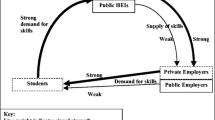Abstract
The dual labor market theory (DLM) posited the existence of two distinct labor markets working in parallel. A primary one is a place where high wages, employment stability and high opportunities for advancement are the norms. On the other hand, low wages, arbitrariness and less desirable working conditions determine a secondary market. The main object of this investigation is to see if differences between schools at the University of Buenos Aires, the most important and populated institution in Argentina, are stark enough to conclude the presence of DLMs. Although some authors have analyzed the higher education market using the DLM theory, in general these approaches have emphasized the presence of two markets in relation to tenured versus non-tenured professors, or between full-time versus part-time faculty members. However, few studies, if any, have tackled the issue of market segmentation in relation to fields of study.
Similar content being viewed by others
References
Altbach, P. (1997) ‘Problems and possibilities: The U.S. Academic Profession, in P. Altbach and M. Filkenstein (eds). Contemporary Higher Education: The Academic Profession, New York: Garland Publishing, pp. 3–20.
Althauser, R.P. and Kalleberg, A.L. (1981) ‘Firms, occupations, and the structure of labor markets: a conceptual analysis’, in I. Berg (ed.), Sociological Perspectives on Labor Markets, New York: Academic Press, pp. 119–149.
Barbier-Gauchard, A., De Palma, F. and Diana, G. (2014) ‘Why should southern economies stay in the Euro Zone? The role of labor markets’, Economic Modelling 43(C): 201–208.
Baron, J. (1984) ‘Organizational perspective on stratification’, Annual Review of Sociology 10(1): 37–69.
Becher, T. (1984) ‘The cultural view’, in B. Clark (ed.), Perspectives in Higher Education: Eight Disciplinary and Comparative Views, Berkeley: University of California Press, pp. 165–198.
Becker, G. (1971) The Economics of Discrimination, Chicago: The University of Chicago Press.
Bernasconi, A. (2009) Gestión del cuerpo académico en las universidades chilenas: La institucionalización de la profesión académica en un contexto de mercado. Paper presented at the International Seminar: The Future of the academic Profession: Challenges for Emerging Countries; 30 March, Buenos Aires, Argentina.
Blau, P. and Duncan, O. (1967) The American occupational structure, New York: Wiley.
Dirección Nacional de Información y Evaluación de la Calidad Educativa (2017) Anuario Estadístico Educativo 2017. https://www.argentina.gob.ar/educacion/planeamiento/info-estadistica/anuarios. Accessed 16 May 2018.
Doeringer, P. and Piore, M. (1971) Internal Labor Markets and Manpower Analysis, Lexington, Massachusetts: Health Lexington Books.
Edmonds, D. (2015) ‘More than half of college faculty are adjuncts: should you care?’Forbes, 28 May.
Eichhorst, W. and Kendzia, M. (2016) ‘Workforce segmentation in Germany: from the founding era to the present time’, The Journal of Labour Market Research 49(4): 297–315.
Gappa, J. and Leslie, D. (1997a) Two Faculties or One? The Conundrum of Part-timers in a Bifurcated Work Force, Washington: American Association for Higher Education.
Gappa, J. and Leslie, D. (1997b) ‘Employment profile of part-timers’, in P. Altbach and M. Filkenstein (eds.) Contemporary Higher Education: The Academic Profession New York: Garland Publishing, pp. 3–20.
Hicks, J. (1963) The Theory of Wages, London: Macmillan.
Lemelle, A. (2002) ‘The effects of the intersection of race, gender and educational class on occupational prestige’, The Western Journal of Black Studies 26(2): 89–97.
Mangan, J. (2000) Workers Without Traditional Employment: An International Study of Non-standard Work, Cheltengam: Edward Elgar Publishing Limited.
Ministerio de Ciencia y Tecnología (2015) Indicadores de Ciencia y Tecnología. Argentina 2015, Buenos Aires: Ministerio de Ciencia, Tecnología, e Innovación Productiva.
Organization for Economic Co-operation and Development (2015) Employment Outlook 2015, Paris: OECD Publishing.
Oi, W. (1962) ‘Labor as a quasi-fixed factor’, Journal of Political Economy 70(6): 535–555.
Pager, D. and Shepherd, H. (2008) ‘The sociology of discrimination: racial discrimination in employment, housing, credit, and consumer markets’, Annual Review of Sociology 34(1): 181–209.
Passaretta, G. and Wolbers, M. (2016) ‘Temporary employment at labour market entry in Europe: labour market dualism, transitions to secure employment and upward mobility’, Economic and Industrial Democracy 40(2): 1–27.
Picault, J. (2013) ‘Unionization and labour-market discrimination: a closer look at non-unionized workers’, Labour 27(3): 272–287.
Piore, M. and Sable, C. (1985) Second Industrial Divide, New York: Basic Books.
Roemer, R. and Schnitz, J. (1982) ‘Academic employment as day labor: the dual labor market in higher education, Journal of Higher Education 53(5): 514–531.
Schutt, R. (2004) Investigating the Social World: The Process and Practice of Research, Thousand Oaks: Pine Forge Press.
Secretaría de Política Universitaria (2016) Sistema universitario. http://portales.educacion.gov.ar/spu/sistema-universitario/. Accessed 16 May 2017.
Secretaría de Políticas Universitarias (2013) Anuario 2013. https://drive.google.com/file/d/1wPoQYcn5lb-YDfl2W-OxgwuoWS2jkBdo/view. Accessed 16 May 2017.
Siegwarth Meyer, C. and Mukerjee, S. (2007) ‘Investigating dual labor market theory for women’, Eastern Economic Journal 33(3): 301–316.
Stigler, G. (1962) ‘The economics of information’, Journal of Political Economy 70(2): 94–105.
Sullivan, T. (1981) ‘Sociological views of labor markets: some missed opportunities and neglected directions, in I. Berg (ed.) Sociological Perspectives of Labor Markets, New York: Academic Press, pp. 329–346.
UBA (2011a) Censo de Docentes. http://www.uba.ar/contenido/294. Accesed 20 November 2018.
UBA (2011b) Censo de Estudiantes. http://www.uba.ar/contenido/294. Accesed 20 November 2018.
UBA (2013) Presupuesto. http://www.uba.ar/contenido/98. Accesed 20 November 2018.
Weick, K. (1976) ‘Educational organizations as loosely coupled systems’, Administrative Science Quarterly 21(1): 1–19.
Williamson, O., Wachter, M. and Harris, J. (1975) ‘Understanding the employment relation: the analysis of idiosyncratic exchange’, Bell Journal of Economics 6(1): 250–278.
Youn, T. (1988) ‘Studies of academia markets and careers: an historical review’, in D. Breneman, and T. Youn (eds.) Academic Labor Markets and Careers, New York: The Falmer Press, pp. 8–27.
Author information
Authors and Affiliations
Corresponding author
Ethics declarations
Conflict of interest
On behalf of all authors, the corresponding author states that there is no conflict of interest.
Additional information
Publisher's Note
Springer Nature remains neutral with regard to jurisdictional claims in published maps and institutional affiliations.
Rights and permissions
About this article
Cite this article
Rabossi, M. Dual Labor Markets in Higher Education? The Case of Two Schools at the University of Buenos Aires. High Educ Policy 34, 1010–1026 (2021). https://doi.org/10.1057/s41307-020-00186-x
Published:
Issue Date:
DOI: https://doi.org/10.1057/s41307-020-00186-x




